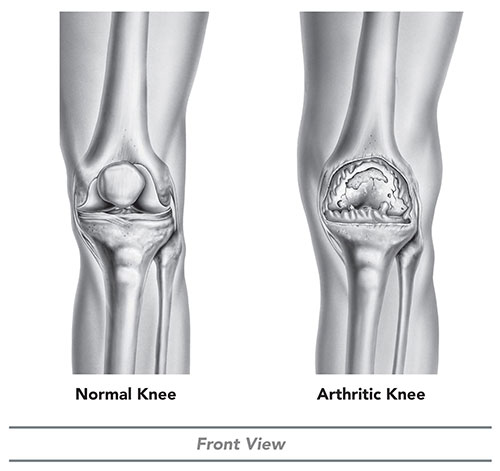The majority of individuals who undergo knee replacement surgery enjoy a marked improvement in quality of life. The elimination of pain and increased range of movement begins just weeks after surgery, and with the right rehabilitation, patients can comfortably enjoy activities that might have become difficult or impossible.
More than 719,000 total knee replacements are performed each year to fix knee joints, according to the Centers for Disease Control and Prevention. It is important to know what to expect before, during and after the procedure to make the most of your recovery and new knee.
What causes people to need knee replacements?
One of the most common causes of total knee replacements is osteoarthritis (OA), also called degenerative joint disease (DJD). This condition occurs from wear and tear on the knee from either an old injury or previous infection. However, the exact cause of OA is unknown.
When OA develops in the knee joint, the smooth cartilage covering the surfaces of the joints
breaks down. When the cartilage breaks down, the bones of the joints grind together causing swelling, pain and small bony growths (bone spurs) to develop. The space in between the bones of the joint narrows, and stiffness develops.
Other conditions such as rheumatoid arthritis (swelling of the tissues around the joint), posttraumatic arthritis from an injury and avascular necrosis (poor blood supply to the joint) can also lead to a knee replacement.

Exactly what is meant by total knee replacement?
Total knee replacement (TKR), also called total knee arthroplasty (TKA), is a surgical procedure where worn or damaged surfaces of the bones of the knee joint are replaced with artificial parts or surfaces. These replacement parts are sometimes referred to as a prosthesis or hardware. In surgery, the bottom portion of the femur, the patella and the top surface of the tibia (the plateau) are removed. The prosthesis is then either cemented to the remaining bones of the femur and tibia or is pinned onto the remaining bone to allow new bone to grow into the prosthesis (noncemented).
Cemented knee joints can last up to 15 years in 95% of patients.
What can I expect after my knee replacement?
The purpose of having joint replacement surgery is to fix your knee joint. Following joint
replacement surgery, you can expect:
- Pain to be eliminated or decreased
- Joints to have better movement
- Daily activities to become easier (climbing stairs, walking and getting into and out of a car)
You could be out of bed and walking within a few hours after surgery. Movement and walking
help to reduce swelling, reduce the risk of developing blood clots and pneumonia and assist in
reducing any pain around your surgical site.
What is the role of rehabilitation after knee replacement surgery following regular post-op care?
Whether you recover in an inpatient rehab setting, nursing facility or at home, physical and occupational therapy will be essential toward recovery and gaining function in your new joint. A physical therapist will evaluate your joint range of motion, muscle strength, ability to walk and ability to get in and out of bed as well as on or off surfaces.
Based on this evaluation, a treatment plan will be developed upon the physician’s orders and may focus on:
- Strengthening and range of motion exercises
- Pain management strategies
- Safety precautions
- Walking with crutches or a walker. You may be able to bear weight on your surgical leg
as tolerated if your physician clears you to do so. - Getting in and out of bed and on and off other surfaces utilizing appropriatesafety precautions
- Educating your family/caregiver on how to assist you in addition to safety precautions
An occupational therapist will assess your arm strength and range of motion, ability to get on and off the toilet and other surfaces, ability to dress, bathe and perform personal hygiene. The OT will also educate you on the use of adaptive equipment for dressing, bathing and other activities including energy conservation.
Total knee replacement is an increasingly viable and attractive option for patients faced with a deteriorating knee joint. If you think you or a loved one is a candidate for surgery, consider having a discussion with your doctor.

